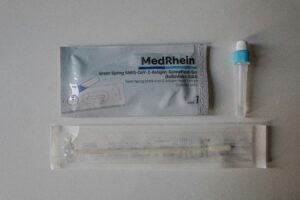In the medical device industry, a single missing record can have severe consequences. Manufacturers face strict regulations, high customer expectations, and the critical responsibility of protecting patient safety. That is why RexMed delivers complete device traceability, covering every step from raw material procurement to final delivery.
This system ensures every component and process is documented, verified, and easily retrievable. With the right system, manufacturers can track a device’s entire history and respond quickly to quality issues. Maintain compliance across multiple markets simultaneously.
What End-to-End traceability means
End-to-end device traceability is more than keeping a few production records. It is about creating a complete, continuous and sustainable chain of information.
The process begins with the verification of raw materials. Every supplier is thoroughly vetted for reliability, and every shipment is carefully inspected for compliance before entering the production process. Each lot of material is assigned a unique identifier, which remains with it throughout the manufacturing cycle.
During production, every step—molding, assembly, sterilization, and final testing—is meticulously logged. This allows teams to see exactly when and where a device was made, which machines were used, and which operators were involved.
The traceability process ends only after the product is packaged, labelled, and shipped. Even then, customer delivery records remain linked to the production data. If a recall becomes necessary, manufacturers can isolate the affected devices within minutes, without halting production or impacting unaffected batches.
By treating traceability as a continuous flow rather than isolated checks, companies reduce risks and improve efficiency. And maintain a clear record for every device in the field.
ISO 13485 Traceability guidelines applied
ISO 13485 is the global standard for quality management in medical device manufacturing. Its traceability requirements go beyond basic batch records. They establish a structured system that connects materials, processes, and final products.
Manufacturers following ISO 13485 must:
- Document every production step
- Maintain lot tracking for all components
- Record supplier qualifications and material certifications
- Verify process controls at each stage
These guidelines strengthen manufacturing compliance and improve risk management. For example, if a supplier changes a raw material formulation, the traceability system will flag the affected batches, enabling faster evaluation and response.
RexMed aligns its workflows with ISO 13485 standards, providing OEM partners with confidence that their devices meet the most demanding regulatory expectations. This ensures compliance not only in domestic markets but also across international borders where regulations may vary.
How traceability helps minimize quality risks

In medical device manufacturing, even a minor defect can have significant implications. Device traceability plays a crucial role in mitigating these risks by linking every product to its corresponding production data.
Imagine a manufacturer discovers a defect in a single lot of surgical instruments. Without proper lot tracking, they might have to recall thousands of units, most of which could be perfectly fine.
Traceability also supports proactive quality assurance. By analyzing historical data, manufacturers can identify patterns that indicate potential problems, such as recurring failures in a specific machine or process. Early detection allows preventive action before defective devices reach customers.
Additionally, clear traceability records enhance communication with regulatory authorities. When auditors request documentation, manufacturers can provide detailed histories within minutes, reducing inspection times and avoiding penalties.
Key components of a reliable traceability system
A truly effective device traceability system requires several essential components. Each element plays a crucial role in ensuring complete transparency, compliance, and quality control throughout the manufacturing process. Below, we explore these key components in detail.
Material traceability
Material traceability begins when raw materials hits the manufacturing facility. Each batch of material must be accompanied by comprehensive documentation that includes supplier information, material certifications, and inspection results.
This documentation ensures that, in the event of a supplier issue or material defect, the affected products can be traced quickly and accurately.
For example, if a raw material batch is found to have contaminants or inconsistencies, manufacturers can use the traceability records to identify all devices that include that material. This limits the scope of recalls and prevents unnecessary disruption of production.
Maintaining strong supplier relationships and conducting regular audits supports ongoing material traceability, helping to uphold quality standards.
Lot labeling
Lot labelling assigns a unique identifier to each batch of devices produced. This label links the product to all relevant manufacturing data, including raw materials, production dates, operators, and inspection results.
An effective lot labelling system enables precise lot tracking, which is essential for identifying, isolating, and managing specific product groups. Labels often include barcodes or QR codes that can be scanned during production and distribution, ensuring accurate, real-time data capture.
Clear and consistent labelling also simplifies communication during audits and recalls, allowing teams to locate the specific lot in question quickly.
Process validations
Process validations confirm that each manufacturing step consistently produces products that meet quality standards. Validations involve testing and documenting procedures, equipment performance, and environmental conditions to ensure compliance with relevant regulations.
Incorporating validations into the traceability system ensures that any deviation or failure during production is recorded. This enables manufacturers to quickly identify root causes and implement corrective actions to prevent recurrence.
For instance, if a sterilization process fails to reach the required parameters, traceability data will link the affected devices to this failure, triggering immediate review and potential rework or disposal.
Inspection records
Inspection records provide evidence that each device meets quality and safety requirements before moving to the next production phase or shipping. These records include visual checks, functional tests, and measurements performed during and after manufacturing.
By capturing inspection data digitally and linking it to lot numbers, manufacturers create a transparent quality history record for every device. This transparency facilitates faster decision-making when quality concerns arise.
Inspection records also demonstrate compliance with regulatory bodies during audits and inspections, reducing the risk of penalties or product holds.
Data integration
A modern traceability system must integrate all collected data into a centralized, easily accessible platform. This integration allows real-time monitoring, instant reporting, and rapid data retrieval.
Data integration ensures no information is lost or siloed in disconnected systems. It empowers manufacturers to run comprehensive analyses on production trends, supplier performance, and quality metrics.
Real-time data access also enhances responsiveness during product recalls, customer inquiries, or regulatory audits, thereby minimizing downtime and protecting the brand’s reputation.
How RexMed implements lot-level traceability
At RexMed, lot-level traceability is not an added feature—it is built into every workflow. Their system tracks each device’s journey from the moment raw materials arrive at the facility.
Incoming materials are scanned, verified, and logged into the database. Production steps are automatically recorded, linking each operation to its lot number. Automated quality assurance checks are performed at multiple points, and the results are stored in the system immediately.
For OEMs, this means complete visibility into their product lifecycle. They can access production data, verify manufacturing compliance, and respond to audits without delay. Because RexMed operates across multiple regulatory jurisdictions, the system is designed to adapt to different legal requirements, ensuring smooth market entry worldwide.
This approach not only meets standards but also builds trust. OEM partners know that their products carry a complete, verifiable history that withstands regulatory scrutiny anywhere in the world.
Conclusion: traceability as a competitive advantage
In a competitive healthcare industry where safety, compliance, and efficiency are non-negotiable, device traceability gives manufacturers a decisive edge. It ensures faster recalls, stronger quality assurance, and smoother market approvals.
RexMed offers OEMs a proven, ISO 13485–aligned solution that manages every stage of the process—from raw materials to customer delivery. Their lot-level tracking system reduces risk, strengthens regulatory compliance, and builds lasting customer confidence.
If your business needs a partner who can deliver traceability without compromise, contact RexMed today and discover how their expertise can safeguard your products and your reputation.






